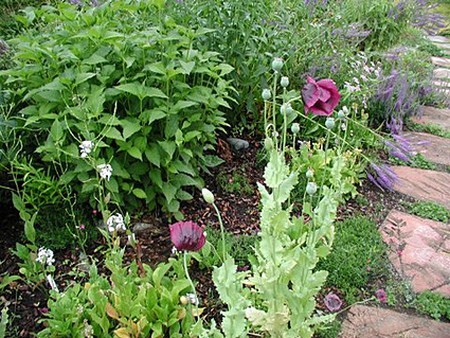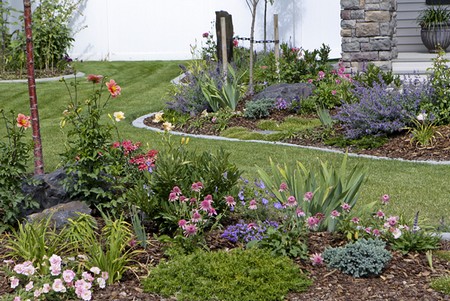Gardens comprise a medley of plants, from herbaceous perennials to shrubs, trees, annuals, biennials, bulbs, ferns and grasses. They look good on their own, but when planted in attractive groups they are even better.
Selecting plants that form attractive partnerships with each other requires careful thought. For example, if they are flowering plants they must create their displays at the same time. Equally, one plant should not dominate and eventually suffocate its neighbour. There are many exciting combinations of plants and by choosing them carefully ‘mix-and-match’ displays can be created throughout the year.
In spring
- Plant the bulbous, blue-flowered Muscari armeniacum (grape hyacinth) in large drifts under the deciduous, slow-growing tree Magnolia stellata (star magnolia) which bears white, star-like, fragrant flowers.
- Plant purple-blue forms ofthe bulbous, large-flowered Dutch crocuses around the deciduous shrub Ribessanguineum ‘King Edward VII’ (flowering currant), with deep crimson flowers.
- Plant golden forms of Dutch crocuses around the evergreen shrub Ribes laurifolium, which bears pendent, greenish-yellow flowers. This combination is ideal for a large rock garden.
- Plant the bulbous, sky-blue-flowered Chionodoxasardensis (glory ofthe snow) around the white-flowered Rhododendron ‘Bric-a-brac’ Group. This arrangement is also ideal for a rock garden.
Early summer
- In a corner of a woodland garden plant the fragrant, yellow-flowered Rhododendron luteum with a sea of bluebells in front.
- Plant the rose-purple flowered Erica australis (Spanish heath) in front ofthe yellow-flowered Ulexeuropaeus ‘Plenus’ (gorse). This is an ideal arrangement where the gorse is used as a boundary.
- Plant hardy, dwarf, deciduous azaleas in colors including red, pink, apricot and orange under the outer extremes ofthe branches ofthe yellow-flowered, deciduous tree, Laburnumanagyroides (golden rain).
Mid-summer
- Plant the bulbous Lilium candidum (Madonna lily), with white, trumpet-shaped flowers and golden pollen, with the hardy biennial Digitalis purpurea (foxglove). The addition of Meconopsis cambrica (Welsh poppy), a hardy perennial with bright- yellow, poppy-like flowers, adds further color to the display.
- For a white-and-silver display, plant the bulbous, white-flowered Lilium regale among the hardy herbaceous perennial Artemisia ludoviciana, which reveals white leaves.
- Plant the deciduous shrub Hydrangea arborescens ‘Grandiflora’, with pure-white flowers borne in large, rounded clusters, in front of a hedge of Taxus baccata (yew). The dark green foliage of the yew highlights the hydrangea’s flowers.
Late summer
- Plant the hardy herbaceous perennial Salvia x superba, with tall spires of rich, purple-blue flowers, in front of the bulbous Lilium henryi, with pale, apricot-yellow flowers with red spots.
- For a white-and-silver display, plant Yucca flaccida ‘Ivory’, with white, bell-shaped flowers and a distinctive ‘architectural’ appearance, in a sea of the silver-leaved Senecio cineraria ‘White Diamond’ or ‘Silver Dust’ (previously known as Cineraria maritima).
Autumn
- Plant the late-flowering Clematis flammula, a bushy and deciduous type with pure-white, sweetly-scented flowers to cover a low arch or trellis, with the herbaceous perennial Aconitum carmichaelii in front. This monkshood (previously and still better known as A. wilsonif) displays pyramids of amethyst-blue flowers. ‘Barker’s Variety’ has deep blue flowers.
- Plant Sedum spectabile (ice plant), which has pink flowers that assume a mauve tinge in autumn, with the bulbous Colchicumspeciosum (autumn crocus). This crocus has rose-purple, goblet-shaped flowers that appear before its leaves.
Categories
Advertisements
Recent Articles
 How to Understand Bed Sizes – A Small Guide
How to Understand Bed Sizes – A Small Guide How to Select Some Must Have Kitchen Accessories
How to Select Some Must Have Kitchen Accessories Best Way to Change a Car Tire
Best Way to Change a Car Tire Best Way to Write an Affirmation
Best Way to Write an Affirmation Best Way to Take Charge of Your Financial Life
Best Way to Take Charge of Your Financial Life Best Way to Survive a Party When You Don’t Know Anyone
Best Way to Survive a Party When You Don’t Know Anyone Best Way to Stop Self Sabotaging Yourself
Best Way to Stop Self Sabotaging Yourself Best Way to Start Journal Writing
Best Way to Start Journal Writing Best Way to Speak with a Powerful Voice
Best Way to Speak with a Powerful Voice Best Way to Simplify Your Life
Best Way to Simplify Your Life Best Way to Respond to a Put-Down
Best Way to Respond to a Put-Down Best Way to Reduce Acne Breakouts
Best Way to Reduce Acne Breakouts Best Way to Recover from Dining Disasters
Best Way to Recover from Dining Disasters Best Way to Quit Your Job Gracefully
Best Way to Quit Your Job Gracefully Best Way to Make Your Own Website
Best Way to Make Your Own Website
Tags
Acid Reflux
Allergy
Aromatherapy
Baby
Baby Learn
Beauty
Bed Rest
Child
Decorate Garden
Depression
Develop Baby Skills
Exercise
Feng Shui
Garden
Golf
Golf Swing
Growing Herbs
Hair
Herbs
Improve Garden
Interview
Interviews
Kitchen
Life
Makeup
Massage
Meditation
Newborn Baby
Plant
plants
Pregnancy
Reduce Stress
Relax
Sales Team
School
Skin
Skin Care
Stress
Stress Reducing
Teach Child
Teacher
Teaching
Train Dog
Understand Baby
Vegetable Garden



Leave a Reply